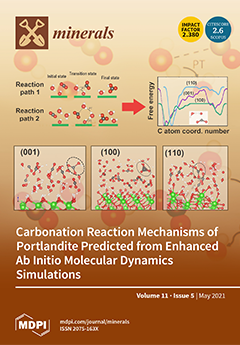Tamuraite, ideally Ir
5Fe
10S
16, occurs as discrete phases (≤20 μm) in composite inclusions hosted by grains of osmium (≤0.5 mm across) rich in Ir, in association with other platinum-group minerals in the River Ko deposit of the Sisim Placer Zone, southern Krasnoyarskiy Kray, Russia. In droplet-like inclusions, tamuraite is typically intergrown with Rh-rich pentlandite and Ir-bearing members of the laurite–erlichmanite series (up to ~20 mol.% “IrS
2”). Tamuraite is gray to brownish gray in reflected light. It is opaque, with a metallic luster. Its bireflectance is very weak to absent. It is nonpleochroic to slightly pleochroic (grayish to light brown tints). It appears to be very weakly anisotropic. The calculated density is 6.30 g·cm
−3. The results of six WDS analyses are Ir 29.30 (27.75–30.68), Rh 9.57 (8.46–10.71), Pt 1.85 (1.43–2.10), Ru 0.05 (0.02–0.07), Os 0.06 (0.03–0.13), Fe 13.09 (12.38–13.74), Ni 12.18 (11.78–13.12), Cu 6.30 (6.06–6.56), Co 0.06 (0.04–0.07), S 27.23 (26.14–27.89), for a total of 99.69 wt %. This composition corresponds to (Ir
2.87Rh
1.75Pt
0.18Ru
0.01Os
0.01)
Σ4.82(Fe
4.41Ni
3.90Cu
1.87Co
0.02)
Σ10.20S
15.98, calculated based on a total of 31 atoms per formula unit. The general formula is (Ir,Rh)
5(Fe,Ni,Cu)
10S
16. Results of synchrotron micro-Laue diffraction studies indicate that tamuraite is trigonal. Its probable space group is
R3m (#166), and the unit-cell parameters are
a = 7.073(1) Å,
c = 34.277(8) Å,
V = 1485(1) Å
3, and Z = 3. The
c:
a ratio is 4.8462. The strongest eight peaks in the X-ray diffraction pattern [
d in Å(
hkl)(I)] are: 3.0106(2
16)(100), 1.7699(4
20)(71), 1.7583(2016)(65), 2.7994(205)(56), 2.9963(1010)(50), 5.7740(10
2)(45), 3.0534(20
1)(43) and 2.4948(208)(38). The crystal structure is derivative of pentlandite and related to that of oberthürite and torryweiserite. Tamuraite crystallized from a residual melt enriched in S, Fe, Ni, Cu, and Rh; these elements were incompatible in the Os–Ir alloy that nucleated in lode zones of chromitites in the Lysanskiy layered complex, Eastern Sayans, Russia. The name honors Nobumichi Tamura, senior scientist at the Advanced Light Source of the Lawrence Berkeley National Laboratory, Berkeley, California.
Full article





